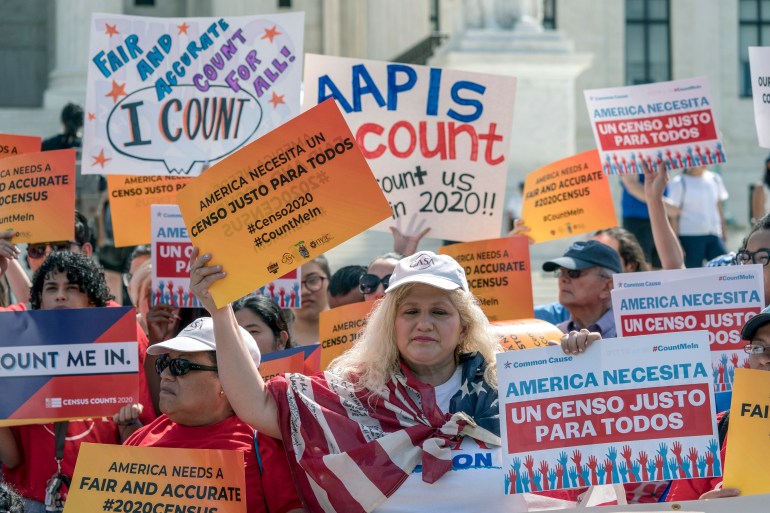White population shrinks as US becomes more diverse: Census
New Census Bureau data reveals the US’s white population dropped for the first time in the country’s history.

The United States is more ethnically diverse and more urban than a decade ago, and the white population dropped for the first time on record, the US Census Bureau says as it releases a trove of demographic data that will be used to redraw the nation’s political maps.
The new data released on Thursday show an increasingly diverse country, with significant increases among people who identify as multiracial, Hispanic and Asian driving much of the population growth between 2010 and 2020.
Keep reading
list of 3 itemsUS census gives Texas, Florida more seats in Congress
US Supreme Court dismisses challenge to Trump census plan
The total number of non-Hispanic white people, which remains the largest race or ethnic group, declined by 8.6 percent during the decade, resulting in a reduction of 5.6 percent as a share of the total US population, now comprising 57.8 percent – the lowest share on record, though white people continue to be the most prevalent racial or ethnic group.
“The US population is much more multiracial and much more racially and ethnically diverse than what we have measured in the past,” said Nicholas Jones, a Census Bureau official.
Today’s release of #2020Census redistricting data provides a new snapshot of the racial and ethnic composition of the country as a result of improvements in the design of the race and ethnicity questions, processing and coding. Read more: https://t.co/HGkCFGnQY9 pic.twitter.com/GOMIB97FHo
— U.S. Census Bureau (@uscensusbureau) August 12, 2021
The data also offered new details on the country’s slowing rate of population growth, which is lower than it has been at any time aside from the 1930s.
More than half of all US counties lost population from 2010 to 2020, census officials said.
New York, Los Angeles, Chicago, Houston and Phoenix are the five largest US cities; Phoenix, which grew faster than any other city in the top 10, surpassed Philadelphia.
The figures show continued migration to the South and West at the expense of counties in the Midwest and Northeast.
The fastest-growing cities across the US are in suburban areas, data showed. Buckeye, a suburb of Phoenix, saw its population increase by nearly 80 percent to lead the nation.
The Villages, a retirement community in Florida, is the fastest-growing metro area in the country, the census said.

The release arrived months later than originally expected after the census took longer to complete due to the coronavirus pandemic. The delay has forced some states to go to court to postpone their redistricting deadlines.
Data kicks off legislative redistricting
Thursday’s release from the US Census Bureau also marks the start of what will be a fierce partisan battle over redistricting, as states use the local data to begin drawing congressional and state legislative districts for the next decade.
States use the data to redraw district lines for the US House of Representatives after each decennial census, based on where people now reside.
In April, the bureau published state-level figures, showing that Texas, Florida and North Carolina – all states controlled by Republicans – will gain congressional seats next year based on increased populations.
Electoral analysts have said Republicans could potentially erase the Democrats’ thin advantage in the House through redistricting alone.

Some experts have questioned whether the census data may have undercounted certain populations, given both the pandemic, as well as the Trump administration’s unsuccessful effort to add a citizenship question to the survey. Civil rights groups had expressed concern that the failed attempt could nevertheless have dissuaded some immigrants from filling out census forms.
“Certainly, the pandemic played a big role, but we can’t forget the political interference we saw,” Terry Ao Minnis, an official with Asian Americans Advancing Justice, an advocacy group told the Associated Press.
“I think we know that all has played a role in whether people participated or not, whether it was from fear created about participating or sheer confusion about, ‘Who is at my door? … Should I not open my door because of COVID? Should I not open my door because of the government?’”
The Census Bureau, however, expressed confidence in the new numbers.
“While no data is perfect, we are confident that today’s redistricting results meet our high data quality standards,” Ron Jarmin, the bureau’s acting director, said on Thursday.